Share This
Since 2005, the Dietary Guidelines for Americans have encouraged all of us to “make at least half our grains whole.” But are we listening? According to new data from the WGC’s 2015 Whole Grains Consumer Insights Survey, the answer is a resounding yes: nearly two-thirds of Americans say they’re making half or more of their grains whole.
With the help of SSI (Survey Sampling International), we reached out to 1,510 U.S. adults from July 27 to August 3, 2015. Our goal was to answer some of the key questions journalists ask us day in and day out: “How has whole grain consumption changed since 2010?”… “What percentage of people have stopped eating gluten?”… “How do consumers actually use the Whole Grain Stamp?”… and more. The responses – highlighted below – were fascinating.
Whole Grain Consumption is Up
-
Nearly two-thirds (64%) have increased whole grain consumption “some” or “a lot” in the last five years. Useful to know, since the most recent official USDA data are from 2010.
-
Almost one-third of respondents (31%) say they nearly always choose whole grains. Five years ago, only 4% would have said this.
-
Another third (32%) choose whole grains about half the time. Combined with the “nearly always” group, this makes 63% making half or more of their grains whole, in line with the Dietary Guidelines for Americans.
-
We eat about 37% of our whole grains at breakfast, 27% at dinner, 22% at lunch, and just 14% as snacks. One possible reason? It’s often harder to find whole grains outside of the home, where most lunches and snacks are generally eaten.
Why we Choose whole grains…
-
Nearly 9 out of 10 (86%) of those who consume whole grains do so for the health benefits. It’s not surprising that most people realize whole grains are healthier.
-
Four in 10 (40%) choose whole grains because they enjoy the taste. Used to be, way back, that taste was at best a neutral factor. Now it’s becoming a real motivator!
And why we don’t
-
Cost was named as the leading barrier to eating more whole grains (39%). Unfortunately, many whole grains – especially breads – cost more than refined grains.
-
Some folks aren’t yet accustomed to the fuller, nuttier taste of whole grains (37%). But we’re glad to see those who prefer the taste of whole grains (40%) are beginning to pull ahead!
-
Availability can also be a barrier (28%), especially since many restaurants don’t offer whole grain choices.
Gluten Confusion Continues
-
Few fully understand gluten. While more than 1 in 3 correctly identify gluten as a protein found in wheat, barley and rye, and 1 in 5 know it makes dough rise, only 4% correctly selected both (and no other options). Although 96% didn’t know the complete answer, only 25% picked “Don’t know.” Other wrong answers chosen? “It’s a dangerous carbohydrate.” (8%)… “It’s an unnatural substance found in genetically modified (GMO) grains.” (11%)… and “It’s a substance that makes you gain weight.” (11%)
-
21% incorrectly think gluten is in all grains. In fact, gluten free doesn’t mean grain free – even those following a gluten-free diet can enjoy grains such as amaranth, buckwheat, corn, millet, oats, quinoa, rice, sorghum, teff, and wild rice.
-
93% eat gluten some or all of the time. Of the 7% who completely avoid gluten, only 1 in 5 has a medically-diagnosed problem with gluten. The bottom line: only 1.5% have a medical reason to avoid gluten completely — a number very much in line with experts’ estimates of celiac disease in the general population.
We Know What We Like — and Like What We Know
-
Old favorites — whole wheat, oats, and brown rice — are most popular with Americans. 9 out of 10 have heard of these three whole grains, and most have eaten them.
-
Despite all the attention paid to “exotic” grains, fewer than 1 in 5 has heard of (let alone tasted!) spelt, farro, amaranth, Kamut®, or teff. We always remind folks that, just as eating a variety of vegetables is healthier, eating a variety of grains is good too — since each one has its own health benefits!
-
When asked to name their one favorite whole grain food, the top choice was whole wheat bread (31%), followed by oatmeal (27%) and then a tie between popcorn and whole grain cold cereal (15% each). Whole grain pasta was the favorite of 8%.
-
In fact, whole grain bread and whole grain cereal (hot and cold) are the two foods most likely to be eaten in whole grain form by Americans.
The Whole Grain Stamp is Known and Trusted
- 49% of people are aware of the Whole Grain Stamp.
-
Eight out of ten (82%) trust the Whole Grain Stamp to accurately state a products’ whole grain content.
-
79% say the Whole Grain Stamp would make them more likely to buy a product; about half of these would also consider sugar, sodium, and other product factors.
-
About half (51%) say they would question a product’s claims about whole grains if they did not see the Whole Grain Stamp.
What are your favorite whole grains and whole grain foods? How often do you choose whole grains? We’d love to hear how you would have responded to this survey! (Cynthia)

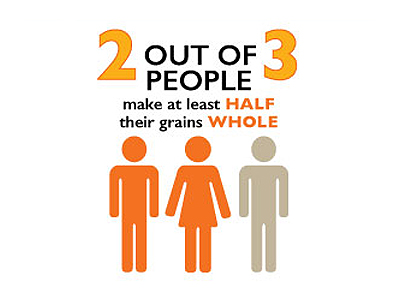
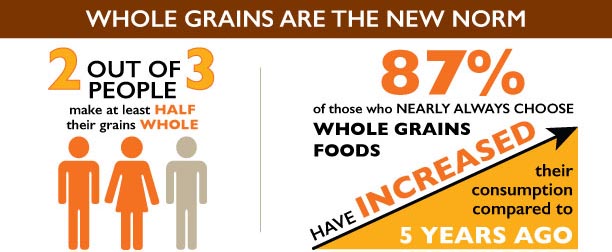
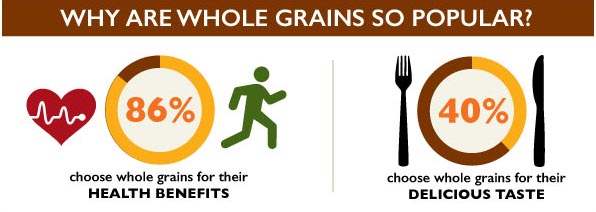
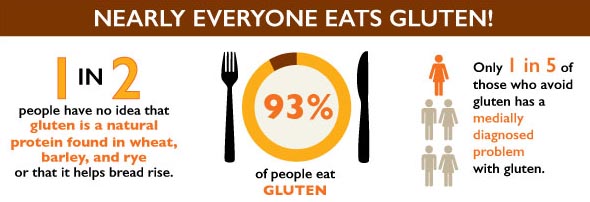
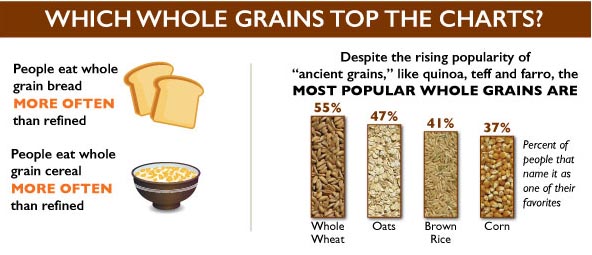
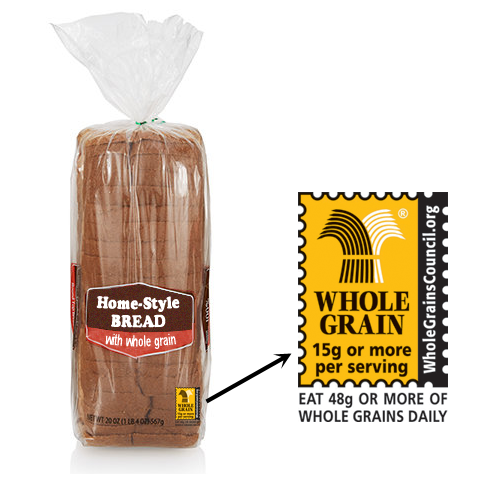
Add a Comment